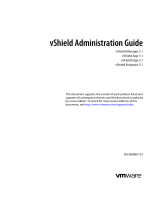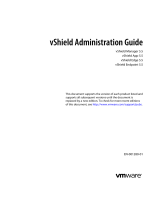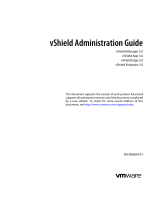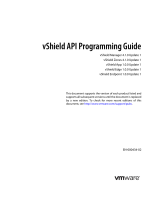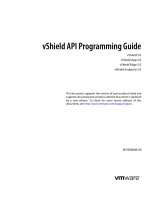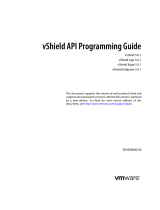Page is loading ...

vShield Quick Start Guide
vShield Manager 5.0.1
vShield App 5.0.1
vShield Edge 5.0.1
vShield Endpoint 5.0.1
This document supports the version of each product listed and
supports all subsequent versions until the document is replaced
by a new edition. To check for more recent editions of this
document, see http://www.vmware.com/support/pubs.
EN-000839-00

vShield Quick Start Guide
2 VMware, Inc.
You can find the most up-to-date technical documentation on the VMware Web site at:
http://www.vmware.com/support/
The VMware Web site also provides the latest product updates.
If you have comments about this documentation, submit your feedback to:
Copyright
©
2010 – 2012 VMware, Inc. All rights reserved. This product is protected by U.S. and international copyright and
intellectual property laws. VMware products are covered by one or more patents listed at
http://www.vmware.com/go/patents.
VMware is a registered trademark or trademark of VMware, Inc. in the United States and/or other jurisdictions. All other marks
and names mentioned herein may be trademarks of their respective companies.
VMware, Inc.
3401 Hillview Ave.
Palo Alto, CA 94304
www.vmware.com

Contents
About this Book 5
1
Introduction to vShield 7
vShield Components at a Glance 7
Deployment Scenarios 10
2
Preparing for Installation 13
System Requirements 13
Deployment Considerations 14
3
Installing the vShield Manager 17
Obtain the vShield Manager OVA File 17
Install the vShield Manager Virtual Appliance 18
Configure the Network Settings of the vShield Manager 18
Log In to the vShield Manager User Interface 19
Synchronize the vShield Manager with the vCenter Server 20
Register the vShield Manager Plug-In with the vSphere Client 20
Change the Password of the vShield Manager User Interface Default Account 21
4
Installing vShield Edge, vShield App, vShield Endpoint, and vShield Data
Security 23
Running vShield Licensed Components in Evaluation Mode 23
Preparing Your Virtual Infrastructure for vShield App, vShield Edge, vShield Endpoint, and vShield
Data Security 23
Installing vShield Endpoint 27
Installing vShield Data Security 28
5
Uninstalling vShield Components 31
Uninstall a vShield App Virtual Appliance 31
Uninstall a vShield Edge from a Port Group 31
Uninstall a vShield Data Security Virtual Machine 32
Uninstall a vShield Endpoint Module 32
6
Upgrading vShield 33
Upgrade the vShield Manager 33
Upgrade vShield App 34
Upgrade vShield Edge 34
Upgrade vShield Endpoint 35
Upgrade vShield Data Security 36
7
vShield Installation Fails 37
VMware, Inc. 3

About this Book
This manual, the vShield Quick Start Guide, describes how to install and configure the VMware
®
vShield™
system by using the vShield Manager user interface, the vSphere Client plug-in, and command line interface
(CLI). The information includes step-by-step configuration instructions, and suggested best practices.
Intended Audience
This manual is intended for anyone who wants to install or use vShield in a VMware vCenter environment.
The information in this manual is written for experienced system administrators who are familiar with virtual
machine technology and virtual datacenter operations. This manual assumes familiarity with VMware
Infrastructure 4.x, including VMware ESX, vCenter Server, and the vSphere Client.
VMware Technical Publications Glossary
VMware Technical Publications provides a glossary of terms that might be unfamiliar to you. For definitions
of terms as they are used in VMware technical documentation, go to http://www.vmware.com/support/pubs.
Document Feedback
VMware welcomes your suggestions for improving our documentation. If you have comments, send your
feedback to [email protected].
Technical Support and Education Resources
The following technical support resources are available to you. To access the current version of this book and
other books, go to http://www.vmware.com/support/pubs.
Online and Telephone
Support
To use online support to submit technical support requests, view your product
and contract information, and register your products, go to
http://www.vmware.com/support.
Customers with appropriate support contracts should use telephone support
for the fastest response on priority 1 issues. Go to
http://www.vmware.com/support/phone_support.html.
Support Offerings
To find out how VMware support offerings can help meet your business needs,
go to http://www.vmware.com/support/services.
VMware Professional
Services
VMware Education Services courses offer extensive hands-on labs, case study
examples, and course materials designed to be used as on-the-job reference
tools. Courses are available onsite, in the classroom, and live online. For onsite
pilot programs and implementation best practices, VMware Consulting
VMware, Inc. 5

Introduction to vShield 1
This chapter introduces the VMware
®
vShield™ components you install.
This chapter includes the following topics:
n
“vShield Components at a Glance,” on page 7
n
“Deployment Scenarios,” on page 10
vShield Components at a Glance
VMware vShield is a suite of security virtual appliances built for VMware vCenter Server integration. vShield
is a critical security component for protecting virtualized datacenters from attacks and misuse helping you
achieve your compliance-mandated goals.
vShield includes virtual appliances and services essential for protecting virtual machines. vShield can be
configured through a web-based user interface, a vSphere Client plug-in, a command line interface (CLI), and
REST API.
vCenter Server includes vShield Manager. The following vShield packages each require a license:
n
vShield App
n
vShield App with Data Security
n
vShield Edge
n
vShield Endpoint
One vShield Manager manages multiple vShield App, vShield Edge, vShield Endpoint, and vShield Data
Security instances.
n
vShield Manager on page 8
The vShield Manager is the centralized network management component of vShield, and is installed as
a virtual appliance on any ESX™ host in your vCenter Server environment. A vShield Manager can run
on a different ESX host from your vShield agents.
n
vShield App on page 8
vShield App is a hypervisor-based firewall that protects applications in the virtual datacenter from
network based attacks. Organizations gain visibility and control over network communications between
virtual machines. You can create access control policies based on logical constructs such as VMware
vCenter™ containers and vShield security groups—not just physical constructs such as IP addresses. In
addition, flexible IP addressing offers the ability to use the same IP address in multiple tenant zones to
simplify provisioning.
VMware, Inc.
7

n
vShield Edge on page 9
vShield Edge provides network edge security and gateway services to isolate the virtual machines in a
port group, vDS port group, or Cisco Nexus 1000V. The vShield Edge connects isolated, stub networks
to shared (uplink) networks by providing common gateway services such as DHCP, VPN, NAT, and
Load Balancing. Common deployments of vShield Edge include in the DMZ, VPN Extranets, and multi-
tenant Cloud environments where the vShield Edge provides perimeter security for Virtual Datacenters
(VDCs).
n
vShield Endpoint on page 10
vShield Endpoint offloads antivirus and anti-malware agent processing to a dedicated secure virtual
appliance delivered by VMware partners. Since the secure virtual appliance (unlike a guest virtual
machine) doesn't go offline, it can continuously update antivirus signatures thereby giving uninterrupted
protection to the virtual machines on the host. Also, new virtual machines (or existing virtual machines
that went offline) are immediately protected with the most current antivirus signatures when they come
online.
n
vShield Data Security on page 10
vShield Data Security provides visibility into sensitive data stored within your organization's virtualized
and cloud environments. Based on the violations reported by vShield Data Security, you can ensure that
sensitive data is adequately protected and assess compliance with regulations around the world.
vShield Manager
The vShield Manager is the centralized network management component of vShield, and is installed as a virtual
appliance on any ESX™ host in your vCenter Server environment. A vShield Manager can run on a different
ESX host from your vShield agents.
Using the vShield Manager user interface or vSphere Client plug-in, administrators install, configure, and
maintain vShield components. The vShield Manager user interface leverages the VMware Infrastructure SDK
to display a copy of the vSphere Client inventory panel, and includes the Hosts & Clusters and Networks
views.
vShield App
vShield App is a hypervisor-based firewall that protects applications in the virtual datacenter from network
based attacks. Organizations gain visibility and control over network communications between virtual
machines. You can create access control policies based on logical constructs such as VMware vCenter™
containers and vShield security groups—not just physical constructs such as IP addresses. In addition, flexible
IP addressing offers the ability to use the same IP address in multiple tenant zones to simplify provisioning.
You should install vShield App on each ESX host within a cluster so that VMware vMotion operations work
and virtual machines remain protected as they migrate between ESX hosts. By default, a vShield App virtual
appliance cannot be moved by using vMotion.
The Flow Monitoring feature displays network activity between virtual machines at the application protocol
level. You can use this information to audit network traffic, define and refine firewall policies, and identify
botnets.
vShield Quick Start Guide
8 VMware, Inc.

vShield Edge
vShield Edge provides network edge security and gateway services to isolate the virtual machines in a port
group, vDS port group, or Cisco Nexus 1000V. The vShield Edge connects isolated, stub networks to shared
(uplink) networks by providing common gateway services such as DHCP, VPN, NAT, and Load Balancing.
Common deployments of vShield Edge include in the DMZ, VPN Extranets, and multi-tenant Cloud
environments where the vShield Edge provides perimeter security for Virtual Datacenters (VDCs).
Standard vShield Edge Services (Including Cloud Director)
Firewall
Supported rules include IP 5-tuple configuration with IP and port ranges for
stateful inspection for TCP, UDP, and ICMP.
Network Address
Translation
Separate controls for Source and Destination IP addresses, as well as TCP and
UDP port translation.
Dynamic Host
Configuration Protocol
(DHCP)
Configuration of IP pools, gateways, DNS servers, and search domains.
Advanced vShield Edge Services
Site-to-Site Virtual
Private Network (VPN)
Uses standardized IPsec protocol settings to interoperate with all major firewall
vendors.
Load Balancing
Simple and dynamically configurable virtual IP addresses and server groups.
vShield Edge supports syslog export for all services to remote servers.
Figure 1-1. vShield Edge Installed to Secure a vDS Port Group
Chapter 1 Introduction to vShield
VMware, Inc. 9

vShield Endpoint
vShield Endpoint offloads antivirus and anti-malware agent processing to a dedicated secure virtual appliance
delivered by VMware partners. Since the secure virtual appliance (unlike a guest virtual machine) doesn't go
offline, it can continuously update antivirus signatures thereby giving uninterrupted protection to the virtual
machines on the host. Also, new virtual machines (or existing virtual machines that went offline) are
immediately protected with the most current antivirus signatures when they come online.
vShield Endpoint installs as a hypervisor module and security virtual appliance from a third-party antivirus
vendor (VMware partners) on an ESX host. The hypervisor scans guest virtual machines from the outside,
removing the need for agents in every virtual machine. This makes vShield Endpoint efficient in avoiding
resource bottlenecks while optimizing memory use.
Figure 1-2. vShield Endpoint Installed on an ESX Host
vShield Data Security
vShield Data Security provides visibility into sensitive data stored within your organization's virtualized and
cloud environments. Based on the violations reported by vShield Data Security, you can ensure that sensitive
data is adequately protected and assess compliance with regulations around the world.
Deployment Scenarios
Using vShield, you can build secure zones for a variety of virtual machine deployments. You can isolate virtual
machines based on specific applications, network segmentation, or custom compliance factors. Once you
determine your zoning policies, you can deploy vShield to enforce access rules to each of these zones.
n
Protecting the DMZ on page 11
The DMZ is a mixed trust zone. Clients enter from the Internet for Web and email services, while services
within the DMZ might require access to services inside the internal network.
vShield Quick Start Guide
10 VMware, Inc.

n
Isolating and Protecting Internal Networks on page 11
You can use a vShield Edge to isolate an internal network from the external network. A vShield Edge
provides perimeter firewall protection and edge services to secure virtual machines in a port group,
enabling communication to the external network through DHCP, NAT, and VPN.
n
Protecting Virtual Machines in a Cluster on page 12
You can use vShield App to protect virtual machines in a cluster.
n
Common Deployments of vShield Edge on page 12
You can use a vShield Edge to isolate a stub network, using NAT to allow traffic in and out of the network.
If you deploy internal stub networks, you can use vShield Edge to secure communication between
networks by using LAN-to-LAN encryption via VPN tunnels.
n
Common Deployments of vShield App on page 12
You can use vShield App to create security zones within a vDC. You can impose firewall policies on
vCenter containers or Security Groups, which are custom containers you can create by using the vShield
Manager user interface. Container-based policies enable you to create mixed trust zones clusters without
requiring an external physical firewall.
Protecting the DMZ
The DMZ is a mixed trust zone. Clients enter from the Internet for Web and email services, while services
within the DMZ might require access to services inside the internal network.
You can place DMZ virtual machines in a port group and secure that port group with a vShield Edge. vShield
Edge provides access services such as firewall, NAT, and VPN, as well as load balancing to secure DMZ
services.
A common example of a DMZ service requiring an internal service is Microsoft Exchange. Microsoft Outlook
Web Access (OWA) commonly resides in the DMZ cluster, while the Microsoft Exchange back end is in the
internal cluster. On the internal cluster, you can create firewall rules to allow only Exchanged-related requests
from the DMZ, identifying specific source-to-destination parameters. From the DMZ cluster, you can create
rules to allow outside access to the DMZ only to specific destinations using HTTP, FTP, or SMTP.
Isolating and Protecting Internal Networks
You can use a vShield Edge to isolate an internal network from the external network. A vShield Edge provides
perimeter firewall protection and edge services to secure virtual machines in a port group, enabling
communication to the external network through DHCP, NAT, and VPN.
Within the secured port group, you can install a vShield App instance on each ESX host that the vDS spans to
secure communication between virtual machines in the internal network.
If you utilize VLAN tags to segment traffic, you can use App Firewall to create smarter access policies. Using
App Firewall instead of a physical firewall allows you to collapse or mix trust zones in shared ESX clusters.
By doing so, you gain optimal utilization and consolidation from features such as DRS and HA, instead of
having separate, fragmented clusters. Management of the overall ESX deployment as a single pool is less
complex than having separately managed pools.
For example, you use VLANs to segment virtual machine zones based on logical, organizational, or network
boundaries. Leveraging the Virtual Infrastructure SDK, the vShield Manager inventory panel displays a view
of your VLAN networks under the Networks view. You can build access rules for each VLAN network to
isolate virtual machines and drop untagged traffic to these machines.
Chapter 1 Introduction to vShield
VMware, Inc. 11

Protecting Virtual Machines in a Cluster
You can use vShield App to protect virtual machines in a cluster.
In Figure 1-3, vShield App instances are installed on each ESX host in a cluster. Virtual machines are protected
when moved via vMotion or DRS between ESX hosts in the cluster. Each vApp shares and maintains state of
all transmissions.
Figure 1-3. vShield App Instances Installed on Each ESX Host in a Cluster
Common Deployments of vShield Edge
You can use a vShield Edge to isolate a stub network, using NAT to allow traffic in and out of the network. If
you deploy internal stub networks, you can use vShield Edge to secure communication between networks by
using LAN-to-LAN encryption via VPN tunnels.
vShield Edge can be deployed as a self-service application within VMware Cloud Director.
Common Deployments of vShield App
You can use vShield App to create security zones within a vDC. You can impose firewall policies on vCenter
containers or Security Groups, which are custom containers you can create by using the vShield Manager user
interface. Container-based policies enable you to create mixed trust zones clusters without requiring an
external physical firewall.
In a deployment that does not use vDCs, use a vShield App with the Security Groups feature to create trust
zones and enforce access policies.
Service Provider Admins can use vShield App to impose broad firewall policies across all guest virtual
machines in an internal network. For example, you can impose a firewall policy on the second vNIC of all guest
virtual machines that allows the virtual machines to connect to a storage server, but blocks the virtual machines
from addressing any other virtual machines.
vShield Quick Start Guide
12 VMware, Inc.

Preparing for Installation 2
This chapter introduces tan overview of the prerequisites for successful vShield installation.
This chapter includes the following topics:
n
“System Requirements,” on page 13
n
“Deployment Considerations,” on page 14
System Requirements
Before you install vShield in your vCenter Server environment, consider your network configuration and
resources. You can install one vShield Manager per vCenter Server, one vShield App or one vShield Endpoint
per ESX™ host, and one vShield Edge per port group.
Hardware
Table 2-1. Hardware Requirements
Component Minimum
Memory 8GB for all vShield components
Disk Space
n
8GB for the vShield Manager
n
5GB per vShield App per ESX host
n
200MB per vShield Edge
n
6GB for vShield Data Security per ESX host
NICs 2 gigabit NICs on an ESX host for all vShield components
Software
For the latest interoperability information, see the Product Interoperability Matrix at
http://partnerweb.vmware.com/comp_guide/sim/interop_matrix.php.
These are the minimum required versions of VMware products.
n
VMware vCenter Server 4.0 Update 2 or later
n
VMware ESX 4.0 Update 2 or later for each server
NOTE vShield Endpoint and vShield Data Security require ESXi 5.0 Patch 1 and later or ESXi 4.1 Patch 3
and later.
n
VMware Tools
VMware, Inc.
13

For vShield Endpoint and vShield Data Security, you must upgrade your virtual machines to hardware
version 7 or 8 and install VMware Tools 8.6.0 released with ESXi 5.0 Patch 1. For more information, see
“Install VMware Tools on the Guest Virtual Machines,” on page 28.
n
VMware vCloud Director 1.0 or later
n
VMware View 4.5 or later
Client and User Access
n
PC with the VMware vSphere Client
NOTE If you added ESX hosts by name to the vSphere inventory, ensure that DNS names are provided.
Otherwise, vShield Manager cannot resolve the IP addresses.
n
Permissions to add and power on virtual machines
n
Access to the datastore where you store virtual machine files, and the account permissions to copy files
to that datastore
n
Enable cookies on your Web browser to access the vShield Manager user interface
n
vShield Manager port 443 accessible from the ESX host. This port is required to download the OVF file on
the ESX host for deployment.
n
Connect to the vShield Manager using one of the following supported Web browsers:
n
Internet Explorer 6.x and later
n
Mozilla Firefox 1.x and later
n
Safari 1.x or 2.x
Deployment Considerations
Consider the following recommendations and restrictions before you deploy vShield components.
n
Preparing Virtual Machines for vShield Protection on page 15
You must determine how to protect your virtual machines with vShield. As a best practise, you should
prepare all ESX hosts within a resource pool for vShield App, vShield Endpoint, and vShield Data
Security depending on the vShield components you are using. You must also upgrade your virtual
machines to hardware version 7 or 8.
n
vShield Manager Uptime on page 15
The vShield Manager should be run on an ESX host that is not affected by downtime, such as frequent
reboots or maintenance mode operations. You can use HA or DRS to increase the resilience of the vShield
Manager. If the ESX host on which the vShield Manager resides is expected to require downtime, vMotion
the vShield Manager virtual appliance to another ESX host. Thus, more than one ESX host is
recommended.
n
Communication Between vShield Components on page 15
The management interfaces of vShield components should be placed in a common network, such as the
vSphere management network. The vShield Manager requires connectivity to the vCenter Server, vShield
App and vShield Edge instances, vShield Endpoint module, and vShield Data Security virtual machine.
vShield components can communicate over routed connections as well as different LANs.
n
Hardening Your vShield Virtual Machines on page 15
You can access the vShield Manager and other vShield components by using a web-based user interface,
command line interface, and REST API. vShield includes default login credentials for each of these access
options. After installation of each vShield virtual machine, you should harden access by changing the
default login credentials. Note that vShield Data Security does not include default login credentials.
vShield Quick Start Guide
14 VMware, Inc.

Preparing Virtual Machines for vShield Protection
You must determine how to protect your virtual machines with vShield. As a best practise, you should prepare
all ESX hosts within a resource pool for vShield App, vShield Endpoint, and vShield Data Security depending
on the vShield components you are using. You must also upgrade your virtual machines to hardware version
7 or 8.
Consider the following questions:
How Are My Virtual Machines Grouped?
You might consider moving virtual machines to port groups on a vDS or a different ESX host to group virtual
machines by function, department, or other organizational need to improve security and ease configuration
of access rules. You can install vShield Edge at the perimeter of any port group to isolate virtual machines from
the external network. You can install a vShield App on an ESX host and configure firewall policies per container
resource to enforce rules based on the hierarchy of resources.
Are My Virtual Machines Still Protected if I vMotion Them to Another ESX Host?
Yes, if the hosts in a resource pool are prepared, you can migrate machines between hosts without weakening
the security posture. For information on preparing your ESX hosts, see “Prepare All ESX Hosts,” on
page 24.
vShield Manager Uptime
The vShield Manager should be run on an ESX host that is not affected by downtime, such as frequent reboots
or maintenance mode operations. You can use HA or DRS to increase the resilience of the vShield Manager. If
the ESX host on which the vShield Manager resides is expected to require downtime, vMotion the vShield
Manager virtual appliance to another ESX host. Thus, more than one ESX host is recommended.
Communication Between vShield Components
The management interfaces of vShield components should be placed in a common network, such as the vSphere
management network. The vShield Manager requires connectivity to the vCenter Server, vShield App and
vShield Edge instances, vShield Endpoint module, and vShield Data Security virtual machine. vShield
components can communicate over routed connections as well as different LANs.
VMware recommends that you install vShield Manager in a different vCenter environment from the one that
vShield Manager manages. Each vShield Manager manages a single vCenter Server environment.
CAUTION Ensure that vCenter is not running on a vShield App protected host that it is managing.
Hardening Your vShield Virtual Machines
You can access the vShield Manager and other vShield components by using a web-based user interface,
command line interface, and REST API. vShield includes default login credentials for each of these access
options. After installation of each vShield virtual machine, you should harden access by changing the default
login credentials. Note that vShield Data Security does not include default login credentials.
n
vShield Manager User Interface on page 16
You access the vShield Manager user interface by opening a web browser window and navigating to the
IP address of the vShield Manager’s management port.
Chapter 2 Preparing for Installation
VMware, Inc. 15

n
Command Line Interface on page 16
You can access the vShield Manager, vShield App, and vShield Edge virtual appliances by using a
command line interface via vSphere Client console session. To access the vShield Endpoint virtual
appliance, refer to the instructions from the anti-virus solution provider. You cannot access the vShield
Data Security virtual machine by using the command line interface.
n
REST Requests on page 16
All REST API requests require authentication with the vShield Manager.
vShield Manager User Interface
You access the vShield Manager user interface by opening a web browser window and navigating to the IP
address of the vShield Manager’s management port.
The default user account, admin, has global access to the vShield Manager. After initial login, you should
change the default password of the admin user account. See “Change the Password of the vShield Manager
User Interface Default Account,” on page 21.
Command Line Interface
You can access the vShield Manager, vShield App, and vShield Edge virtual appliances by using a command
line interface via vSphere Client console session. To access the vShield Endpoint virtual appliance, refer to the
instructions from the anti-virus solution provider. You cannot access the vShield Data Security virtual machine
by using the command line interface.
Each virtual appliance uses the same default username (admin) and password (default) combination as the
vShield Manager user interface. Entering Enabled mode also uses the password default.
For more on hardening the CLI, see the vShield Command Line Interface Reference .
REST Requests
All REST API requests require authentication with the vShield Manager.
Using Base 64 encoding, you identify a username-password combination in the following format:
username:password. You must use a vShield Manager user interface account (username and password) with
privileged access to perform requests. For more on authenticating REST API requests, see the vShield API
Programming Guide.
vShield Quick Start Guide
16 VMware, Inc.

Installing the vShield Manager 3
VMware vShield provides firewall protection, traffic analysis, and network perimeter services to protect your
vCenter Server virtual infrastructure. vShield virtual appliance installation has been automated for most virtual
datacenters.
The vShield Manager is the centralized management component of vShield. You use the vShield Manager to
monitor and push configurations to vShield App, vShield Endpoint, and vShield Edge instances. The vShield
Manager runs as a virtual appliance on an ESX host.
VMware vShield is included with VMware ESX 4.0 and 4.1. The base VMware vShield package includes the
vShield Manager and vShield App. You can configure the vShield App firewall rule set to monitor traffic based
on IP address-to-IP address communication.
Installing the vShield Manager is a multistep process. You must perform all of the tasks that follow in sequence
to complete vShield Manager installation successfully.
To enhance your network security posture, you can obtain licenses for vShield App, vShield Endpoint, and
vShield Edge.
This chapter includes the following topics:
n
“Obtain the vShield Manager OVA File,” on page 17
n
“Install the vShield Manager Virtual Appliance,” on page 18
n
“Configure the Network Settings of the vShield Manager,” on page 18
n
“Log In to the vShield Manager User Interface,” on page 19
n
“Synchronize the vShield Manager with the vCenter Server,” on page 20
n
“Register the vShield Manager Plug-In with the vSphere Client,” on page 20
n
“Change the Password of the vShield Manager User Interface Default Account,” on page 21
Obtain the vShield Manager OVA File
The vShield Manager virtual machine is packaged as an Open Virtualization Appliance (OVA) file, which
allows you to use the vSphere Client to import the vShield Manager into the datastore and virtual machine
inventory.
VMware, Inc.
17

Install the vShield Manager Virtual Appliance
You can install the vShield Manager virtual machine on an ESX host in a cluster configured with DRS.
With vShield 5.0 and later, you can install the vShield Manager in a different vCenter than the one that the
vShield Manager will be interoperating with. A single vShield Manager serves a single vCenter Server
environment.
The vShield Manager virtual machine installation includes VMware Tools. Do not attempt to upgrade or install
VMware Tools on the vShield Manager.
Procedure
1 Log in to the vSphere Client.
2 Create a port group to home the management interface of the vShield Manager.
The vShield Manager management interface must be reachable by all future vShield Edge, vShield App,
and vShield Endpoint instances.
NOTE Do not place the management interface of the vShield Manager in the same port group as the Service
Console and VMkernel.
3 Select File > Deploy OVF Template.
4 Click Deploy from file and click Browse to locate the folder on your PC that contains the vShield Manager
OVA file.
5 Complete the installation.
The vShield Manager is installed as a virtual machine in your inventory.
6 Power on the vShield Manager virtual machine.
Configure the Network Settings of the vShield Manager
You must use the command line interface (CLI) of the vShield Manager to configure an IP address, identify
the default gateway, and set DNS settings.
You can specify up to two DNS servers that the vShield Manager can use for IP address and host name
resolution. DNS is required if any ESX host in your vCenter Server environment was added by using the
hostname (instead of IP address).
Procedure
1 Right-click the vShield Manager virtual machine and click Open Console to open the command line
interface (CLI) of the vShield Manager.
The booting process might take a few minutes.
2 After the manager login prompt appears, log in to the CLI by using the user name admin and the password
default.
3 Enter Enabled mode by using the password default.
manager> enable
Password:
manager#
vShield Quick Start Guide
18 VMware, Inc.

4 Run the setup command to open the CLI setup wizard.
The CLI setup wizard guides you through IP address assignment for the vShield Manager’s management
interface and identification of the default network gateway. The IP address of the management interface
must be reachable by all installed vShield App, vShield Edge, and vShield Endpoint instances, and by a
Web browser for system management.
manager# setup
Use CTRL-D to abort configuration dialog at any prompt.
Default settings are in square brackets '[]'.
IP Address (A.B.C.D):
Subnet Mask (A.B.C.D):
Default gateway (A.B.C.D):
Primary DNS IP (A.B.C.D):
Secondary DNS IP (A.B.C.D):
Old configuration will be lost.
Do you want to save new configuration (y/[n]): y
5 (Optional) If you have configured network settings for the vShield Manager before, you must reboot the
system.
6 Log out and log back in to the CLI by using the user name admin and the password default.
7 Ping the default gateway to verify network connectivity.
manager> ping A.B.C.D
8 From your PC, ping the vShield Manager IP address to validate that the IP address is reachable.
Log In to the vShield Manager User Interface
After you have installed and configured the vShield Manager virtual machine, log in to the vShield Manager
user interface.
Procedure
1 Open a Web browser window and type the IP address assigned to the vShield Manager.
The vShield Manager user interface opens in a web browser window using SSL.
2 Accept the security certificate.
NOTE You can use an SSL certificate for authentication. Refer to the vShield Administration Guide.
The vShield Manager login screen appears.
3 Log in to the vShield Manager user interface by using the user name admin and the password default.
You should change the default password as one of your first tasks to prevent unauthorized use. See
“Change the Password of the vShield Manager User Interface Default Account,” on page 21.
4 Click Log In.
Chapter 3 Installing the vShield Manager
VMware, Inc. 19

Synchronize the vShield Manager with the vCenter Server
Synchronize with your vCenter Server to display your VMware Infrastructure inventory in the vShield
Manager user interface.
You must have a vCenter Server user account with administrative access to complete this task. If your vCenter
password has non-Ascii characters, you must change it before synchronizing the vShield Manager with the
vCenter Server.
NOTE The vShield Manager virtual machine does not appear as a resource in the inventory panel of the vShield
Manager user interface. The Settings & Reports object represents the vShield Manager virtual machine in the
inventory panel.
Procedure
1 Log in to the vShield Manager.
2 Click Settings & Reports from the vShield Manager inventory panel.
3 Click the Configuration tab.
4 Click the vCenter tab.
5 Type the IP address or hostname of your vCenter Server in the IP address/Name field.
6 Type your vSphere Client login user name in the User Name field.
7 Type the password associated with the user name in the Password field.
8 Click Save.
Register the vShield Manager Plug-In with the vSphere Client
The vSphere Plug-in option lets you register the vShield Manager as a vSphere Client plug-in. After the plug-
in is registered, you can configure most vShield options from the vSphere Client.
Procedure
1 Click Settings & Reports from the vShield Manager inventory panel.
2 Click the Configuration tab.
3 Click vSphere Plug-in.
4 Click Register.
For NAT environments, you may need to modify the plug-in script download location. By default, the
vShield Manager address is used as vShield_Manager_IP:443.
5 If you are logged in to the vSphere Client, log out.
6 Log in to the vSphere Client.
7 Select an ESX host.
8 Verify that the vShield tab appears as an option.
vShield Quick Start Guide
20 VMware, Inc.
/



